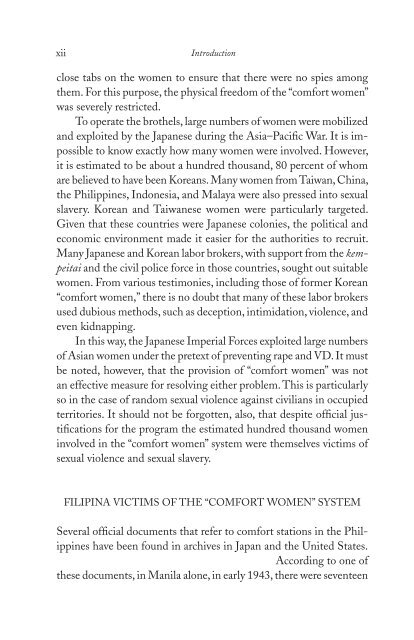Comfort Woman : a Filipina's Story of Prostitution and Slavery Under ...
Comfort Woman : a Filipina's Story of Prostitution and Slavery Under ...
Comfort Woman : a Filipina's Story of Prostitution and Slavery Under ...
You also want an ePaper? Increase the reach of your titles
YUMPU automatically turns print PDFs into web optimized ePapers that Google loves.
xii<br />
Introduction<br />
close tabs on the women to ensure that there were no spies among<br />
them. For this purpose, the physical freedom <strong>of</strong> the “comfort women”<br />
was severely restricted.<br />
To operate the brothels, large numbers <strong>of</strong> women were mobilized<br />
<strong>and</strong> exploited by the Japanese during the Asia–Pacifi c War. It is impossible<br />
to know exactly how many women were involved. However,<br />
it is estimated to be about a hundred thous<strong>and</strong>, 80 percent <strong>of</strong> whom<br />
are believed to have been Koreans. Many women from Taiwan, China,<br />
the Philippines, Indonesia, <strong>and</strong> Malaya were also pressed into sexual<br />
slavery. Korean <strong>and</strong> Taiwanese women were particularly targeted.<br />
Given that these countries were Japanese colonies, the political <strong>and</strong><br />
economic environment made it easier for the authorities to recruit.<br />
Many Japanese <strong>and</strong> Korean labor brokers, with support from the kempeitai<br />
<strong>and</strong> the civil police force in those countries, sought out suitable<br />
women. From various testimonies, including those <strong>of</strong> former Korean<br />
“comfort women,” there is no doubt that many <strong>of</strong> these labor brokers<br />
used dubious methods, such as deception, intimidation, violence, <strong>and</strong><br />
even kidnapping.<br />
In this way, the Japanese Imperial Forces exploited large numbers<br />
<strong>of</strong> Asian women under the pretext <strong>of</strong> preventing rape <strong>and</strong> VD. It must<br />
be noted, however, that the provision <strong>of</strong> “comfort women” was not<br />
an effective measure for resolving either problem. This is particularly<br />
so in the case <strong>of</strong> r<strong>and</strong>om sexual violence against civilians in occupied<br />
territories. It should not be forgotten, also, that despite <strong>of</strong>fi cial justifi<br />
cations for the program the estimated hundred thous<strong>and</strong> women<br />
involved in the “comfort women” system were themselves victims <strong>of</strong><br />
sexual violence <strong>and</strong> sexual slavery.<br />
FILIPINA VICTIMS OF THE “COMFORT WOMEN” SYSTEM<br />
Several <strong>of</strong>fi cial documents that refer to comfort stations in the Philippines<br />
have been found in archives in Japan <strong>and</strong> the United States.<br />
According to one <strong>of</strong><br />
these documents, in Manila alone, in early 1943, there were seventeen

















